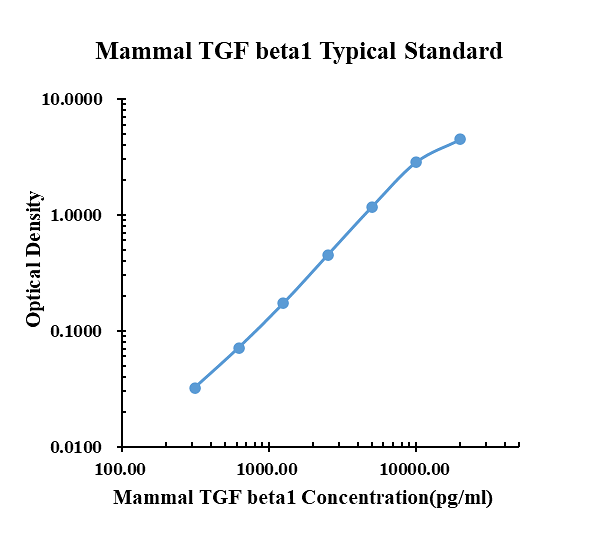Human/Mouse/Rat/Porcine/Canine TGF-β1 enzyme-linked immunoassay kit
| Specification | 96 Test |
|---|---|
| Sensitivity | 33.32 pg/ml (50 μl) |
| Standard Curve Range | 312.5~20000 pg/ml |
| Standard Curve Gradient | 7 Points |
| Number of Incubations | 2 |
| Detectable sample | Liquid phase sample of soluble substances. For example: serum, plasma, cell culture supernatant, tissue grinding liquid, etc. |
| Sample Volume | 50 μl |
| Type | Ready-to-Use |
| Operation Duration | 120min |

| pg/ml | O.D. | Average | Corrected | |
|---|---|---|---|---|
| 0.00 | 0.0219 | 0.0270 | 0.0245 | |
| 312.50 | 0.0561 | 0.0568 | 0.0565 | 0.0320 |
| 625.00 | 0.0973 | 0.0945 | 0.0959 | 0.0715 |
| 1250.00 | 0.1937 | 0.1982 | 0.1960 | 0.1715 |
| 2500.00 | 0.4737 | 0.4704 | 0.4721 | 0.4476 |
| 5000.00 | 1.2210 | 1.1640 | 1.1925 | 1.1681 |
| 10000.00 | 2.8550 | 2.8810 | 2.8680 | 2.8436 |
| 20000.00 | 4.4672 | 4.5023 | 4.4848 | 4.4603 |
Precision
| Intra-assay Precision | Inter-assay Precision | |||||
| Sample Number | S1 | S2 | S3 | S1 | S2 | S3 |
| 22 | 22 | 22 | 6 | 6 | 6 | |
| Average(pg/ml) | 195.0 | 1090.8 | 3619.9 | 237.3 | 1154.4 | 3711.7 |
| Standard Deviation | 10.3 | 67.7 | 202.6 | 16.3 | 67.5 | 144.7 |
| Coefficient of Variation(%) | 5.3 | 6.2 | 5.6 | 6.8 | 5.8 | 3.9 |
Intra-assay Precision (Precision within an assay) Three samples of known concentration were tested twenty times on one plate to assess intra-assay precision.
Inter-assay Precision (Precision between assays) Three samples of known concentration were tested six times on one plate to assess intra-assay precision.
Spike Recovery
The spike recovery was evaluated by spiking 3 levels of mammal TGF beta1 into health serum sample. The un-spiked serum was used as blank in this experiment.
The recovery ranged from 88% to 105% with an overall mean recovery of 99%.
Sample Values
| Sample Matrix | Sample Evaluated | Range (ng/ml) | Detectable (%) | Mean of Detectable (ng/ml) |
|---|---|---|---|---|
| Serum | 30 | 35.3-74.7 | 100 | 58.4 |
Serum/Plasma – Thirty samples from apparently healthy volunteers were evaluated for the presence of TGF-β1 in this assay. No medical histories were available for the donors.
Product Data Sheet
Background: TGF-β1
Transforming Growth Factor Beta 1, 2, and 3 (TGF-beta 1, TGF-beta 2, and TGF-beta 3) are highly pleiotropic cytokines that virtually all cell types secrete. TGF-beta molecules are proposed to act as cellular switches that regulate processes such as immune function, proliferation, and epithelial-mesenchymal transition. Targeted deletions of these genes in mice show that each TGF-beta isoform has some non-redundant functions: TGF-beta 1 is involved in hematopoiesis and endothelial differentiation; TGF-beta 2 affects development of cardiac, lung, craniofacial, limb, eye, ear, and urogenital systems; and TGF-beta 3 influences palatogenesis and pulmonary development. The full range of in vitro biological activities of TGF-beta 5 has not yet been explored. However, TGF-beta 1, TGF-beta 2, TGF-beta 3, and TGF-beta 5 have been found to be largely interchangeable in an inhibitory bioassay, and it is anticipated that TGF-beta 5 will show a spectrum of activities similar to the other TGF-beta family members. To date, the production of TGF-beta 5 has only been demonstrated in Xenopus.
TGF-beta ligands are initially synthesized as precursor proteins that undergo proteolytic cleavage. The mature segments form active ligand dimers via a disulfide-rich core consisting of the characteristic 'cysteine knot'. TGF-beta signaling begins with binding to a complex of the accessory receptor betaglycan (also known as TGF-beta RIII) and a type II serine/threonine kinase receptor termed TGF-beta RII. This receptor then phosphorylates and activates a type I serine/threonine kinase receptor, either ALK-1 or TGF-beta RI (also called ALK-5). The activated type I receptor phosphorylates and activates Smad proteins that regulate transcription. Use of other signaling pathways that are Smad-independent allows for distinct actions observed in response to TGF-beta in different contexts.

